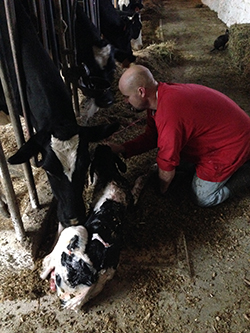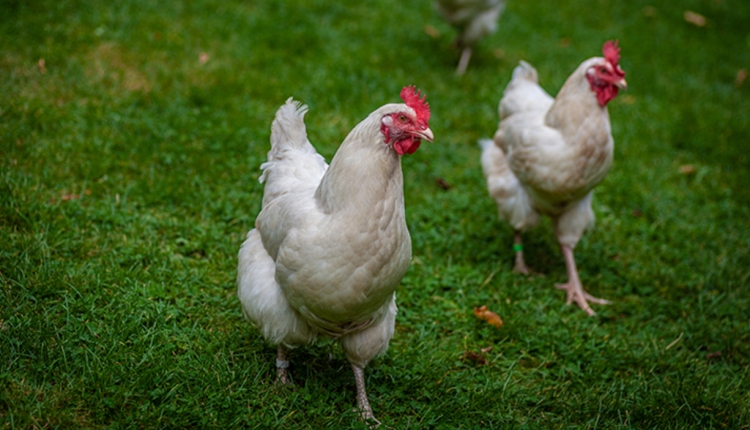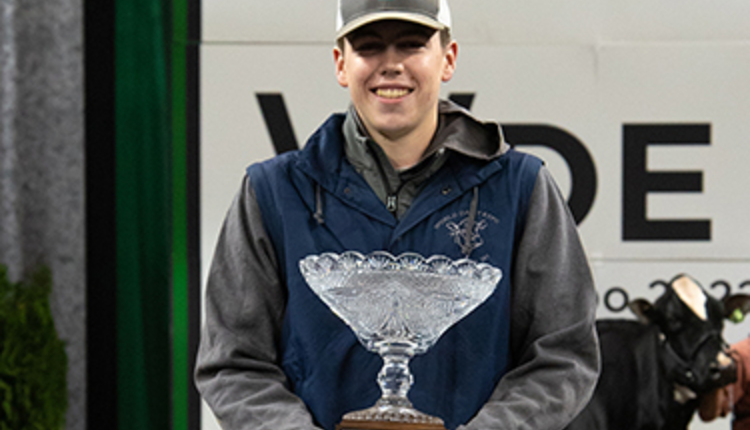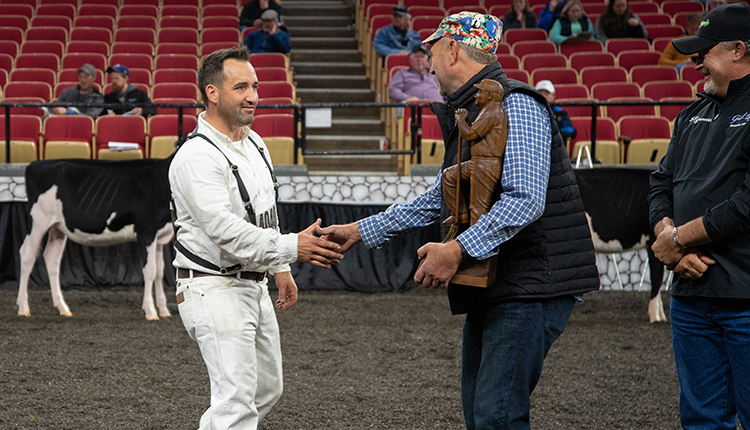Since 1899, the Hoard's Dairyman Farm has played a pivotal role in keeping our editors grounded in the reality of reporting science and, at the same time, making it practical for our extremely busy dairy farm readers. While each of our editors have interactions with the Hoard's Dairyman Farm manager and his staff, five of the six editorial staffers who write for our publication count themselves among the nation's 50,000 dairy farm families. As a result, we not only write about the dairy industry but also live it each day. What follows is a lighthearted account of one editor's experiences on his family's dairy farm one weekend. - The Editors
Recently, the herdsman at my family's farm, Ran-Rose Dairy, was given a well-deserved weekend off. On occasions like this, I typically head home to help at the dairy operation which is run most days by my parents and their herdsman. The farm consists of 65 Holsteins, an equivalent number of heifers and 376 acres. Given the size of the herd, it would be rare to have more than two cows calve on the same day, much less four, but that's exactly what transpired early that Sunday morning.
Knowing one of the farm's best cows could calve any day, I had set my alarm for midnight. On making my way to the barn, sure enough, Elegant, a third-calver, was well on her way to giving birth. The front legs were out and the calf's nose was already passing through the birth canal. Some slight assistance helped finish the delivery. Over the next 45 minutes, the bull calf received the typical newborn care along with a gallon of fresh colostrum from its dam.
After one final sweep of the barn at 1:30 a.m., once calf and dam were cared for, I stopped by Fizzle who already had the amniotic sac presented in her birth canal. I decided to give her some time and worked on a few farm records in the meantime. A half hour later, she, too, delivered a healthy bull calf.
At that point, my father, a gifted cow-care specialist, came out to the barn to check on the status of his part-time farming son. Together, we gave calcium boluses to both fresh cows. Not needing two of us in the barn, he headed back in as I finished tending to the latest newborn.
I attempted to leave the barn at 3:30 a.m., hoping to still get in a few hours of shut-eye, but that's when I noticed Seven11, a first-calver, pushing quite a bit. Sure enough, she was calving, too. That's when I decided our herdsman hit the lottery by picking this weekend to be off. After watching this calving progress for well over an hour, I knew she needed some help, as she was having trouble pushing the head out of the birth canal. After attaching the calf puller, our farm was blessed with a third bull calf that cold winter night.
After that delivery, I knew sleep was no longer on the menu. So, I made some coffee and changed out of my slimy clothes in our farm home. After a few quick sips, it was time to start milking as it was now 5 a.m.
 Upon re-entering the barn, I knew for sure it must have been a full moon because Fiat, another third-calver, joined the maternity party. It was an unusually hard effort for an older cow, but I didn't use the puller, just chains. On the fourth delivery of the early morning, just shy of 6 a.m., I finally delivered a heifer calf that received the name Fat Amy after a movie character. (Not my choice of names, but that is another story.) With no room left in the maternity pen, Fiat gave birth in her stall as shown in the photo captured on my wife's phone.
Upon re-entering the barn, I knew for sure it must have been a full moon because Fiat, another third-calver, joined the maternity party. It was an unusually hard effort for an older cow, but I didn't use the puller, just chains. On the fourth delivery of the early morning, just shy of 6 a.m., I finally delivered a heifer calf that received the name Fat Amy after a movie character. (Not my choice of names, but that is another story.) With no room left in the maternity pen, Fiat gave birth in her stall as shown in the photo captured on my wife's phone.
We, as editors, are not full-time farmers, but we share this story to let all of our readers know that we still experience the same challenges as you do on your dairy farms from time to time. For our founder, W.D. Hoard, our interaction on farms also serves another important purpose:
"I saw that this farm must, in the nature of things, become a very important adjunct of the future welfare of Hoard's Dairyman. Here I could enter upon the demonstration of certain theories of soil tillage, of dairy cattle breeding, of improved crop raising, and particularly that of growing alfalfa. It would also provide a place where Hoard's Dairyman editors could keep their feet on the ground."
 The author is the managing editor, and he brings 18 years of industry leadership to our readers overseeing all editorial content and production of the magazine. His degree from the University of Wisconsin-Madison combined dairy science and agricultural economics.
The author is the managing editor, and he brings 18 years of industry leadership to our readers overseeing all editorial content and production of the magazine. His degree from the University of Wisconsin-Madison combined dairy science and agricultural economics.
Recently, the herdsman at my family's farm, Ran-Rose Dairy, was given a well-deserved weekend off. On occasions like this, I typically head home to help at the dairy operation which is run most days by my parents and their herdsman. The farm consists of 65 Holsteins, an equivalent number of heifers and 376 acres. Given the size of the herd, it would be rare to have more than two cows calve on the same day, much less four, but that's exactly what transpired early that Sunday morning.
Knowing one of the farm's best cows could calve any day, I had set my alarm for midnight. On making my way to the barn, sure enough, Elegant, a third-calver, was well on her way to giving birth. The front legs were out and the calf's nose was already passing through the birth canal. Some slight assistance helped finish the delivery. Over the next 45 minutes, the bull calf received the typical newborn care along with a gallon of fresh colostrum from its dam.
After one final sweep of the barn at 1:30 a.m., once calf and dam were cared for, I stopped by Fizzle who already had the amniotic sac presented in her birth canal. I decided to give her some time and worked on a few farm records in the meantime. A half hour later, she, too, delivered a healthy bull calf.
At that point, my father, a gifted cow-care specialist, came out to the barn to check on the status of his part-time farming son. Together, we gave calcium boluses to both fresh cows. Not needing two of us in the barn, he headed back in as I finished tending to the latest newborn.
I attempted to leave the barn at 3:30 a.m., hoping to still get in a few hours of shut-eye, but that's when I noticed Seven11, a first-calver, pushing quite a bit. Sure enough, she was calving, too. That's when I decided our herdsman hit the lottery by picking this weekend to be off. After watching this calving progress for well over an hour, I knew she needed some help, as she was having trouble pushing the head out of the birth canal. After attaching the calf puller, our farm was blessed with a third bull calf that cold winter night.
After that delivery, I knew sleep was no longer on the menu. So, I made some coffee and changed out of my slimy clothes in our farm home. After a few quick sips, it was time to start milking as it was now 5 a.m.
 Upon re-entering the barn, I knew for sure it must have been a full moon because Fiat, another third-calver, joined the maternity party. It was an unusually hard effort for an older cow, but I didn't use the puller, just chains. On the fourth delivery of the early morning, just shy of 6 a.m., I finally delivered a heifer calf that received the name Fat Amy after a movie character. (Not my choice of names, but that is another story.) With no room left in the maternity pen, Fiat gave birth in her stall as shown in the photo captured on my wife's phone.
Upon re-entering the barn, I knew for sure it must have been a full moon because Fiat, another third-calver, joined the maternity party. It was an unusually hard effort for an older cow, but I didn't use the puller, just chains. On the fourth delivery of the early morning, just shy of 6 a.m., I finally delivered a heifer calf that received the name Fat Amy after a movie character. (Not my choice of names, but that is another story.) With no room left in the maternity pen, Fiat gave birth in her stall as shown in the photo captured on my wife's phone.We, as editors, are not full-time farmers, but we share this story to let all of our readers know that we still experience the same challenges as you do on your dairy farms from time to time. For our founder, W.D. Hoard, our interaction on farms also serves another important purpose:
"I saw that this farm must, in the nature of things, become a very important adjunct of the future welfare of Hoard's Dairyman. Here I could enter upon the demonstration of certain theories of soil tillage, of dairy cattle breeding, of improved crop raising, and particularly that of growing alfalfa. It would also provide a place where Hoard's Dairyman editors could keep their feet on the ground."
 The author is the managing editor, and he brings 18 years of industry leadership to our readers overseeing all editorial content and production of the magazine. His degree from the University of Wisconsin-Madison combined dairy science and agricultural economics.
The author is the managing editor, and he brings 18 years of industry leadership to our readers overseeing all editorial content and production of the magazine. His degree from the University of Wisconsin-Madison combined dairy science and agricultural economics.








